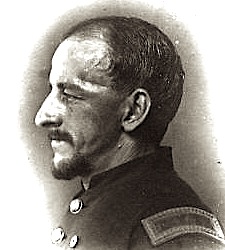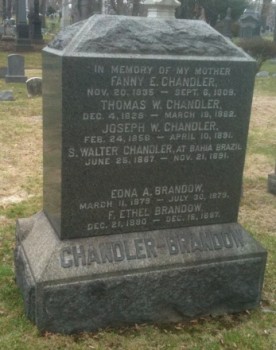Since 2007, our Civil War Project volunteers have been going through the cemetery’s chronological books, looking for men of appropriate age to have served in the Civil War. When they come across one, they fill out a form with the information for that individual: name, birthplace, late residence, place of death, age at time of death, marital status, date of death, date of interment, cemetery lot, and cause of death. I then check this information against several online databases, hoping to find a matching soldier history.
Well, just a few days ago, I had a great find. I was working with a form for a man by the name of Thomas W. Chandler, who according to Green-Wood’s records had died on March 19, 1882, at the age of 52 years, 3 months, and 15 days. Checking a database of Civil War soldiers, I discovered that there were only 4 men by that name who served in the Union Army–out of about 2.5 million men. And, of the approximately 350,000 men who served from New York State, only one was named Thomas W. Chandler. That looked promising. I then calculated the year of birth of the Thomas W. Chandler who is interred at Green-Wood–he was born in 1829. The New York soldier with that same name was also born in 1829. Pretty good!
Checking the information on the Historical Dat Systems website further, I discovered that the soldier had died on March 19, 1882. No question about it–a match!
Here’s what else I found on that website. At the age of 31, Thomas W. Chandler of Astoria, Queens, enlisted as a private in the 67th New York Infantry, Company F. He was steadily promoted: to corporal, sergeant, sergeant major, then re-enlisted, was promoted to second lieutenant, and then transferred into the 65th New York in 1864. But here’s where things got really interesting: he was wounded in the head at Petersburg, Virginia, on March 25, 1865.
And here is the photograph posted on that website by Paul R. Johnson.

You can see Chandler’s scar, from that head wound, above his left eye. Here’s the notation on the photograph: “Minie ball weighed 1 1/4 oz imbedded in his brain for six weeks, it was successfully removed (by John G. Johnson, M.D.), died march 19th, 1882. Congestion of brain from above wound 17 years after close of war.” Wow!
With help from Sue Ramsey, our great researcher out in California, I was able to find Chandler’s obituary that appeared in the Brooklyn Daily Eagle on March 20, 1882. That obituary clarifies the story with this:
He passed through the entire period of the war until March 25, 1865, without injury, when after the capture of Fort Steadman, in an attempt to advance the picket line, he received a gunshot wound in the left temple, which penetrated the brain. After several weeks he succeeded in obtaining a furlough, reached home in safety and placed himself under the charge of Dr. Johnson, of Henry Street, who, after considerable difficulty, succeeded on the 8th of May in removing the ball, which weighed one and a quarter ounces, from his head, it having been in his brain for six weeks and two days.
I guess it was a pretty high standard back then for a furlough–he remained on duty, with a bullet in his brain, until “he succeeded in obtaining a furlough!” That’s tough!
The cemetery records state that Thomas W. Chandler died of meningitis and a gunshot wound. A gunshot wound he had suffered 17 years earlier!

Note that his gravestone in no way indicates his Civil War service. Nor does it tell the remarkable story of the bullet that killed him, years after it was fired into his head.
Jeff,
I thought I had heard the best of the CW stories of Green-Wood…this one ranks way up there (and close to home). Great find!